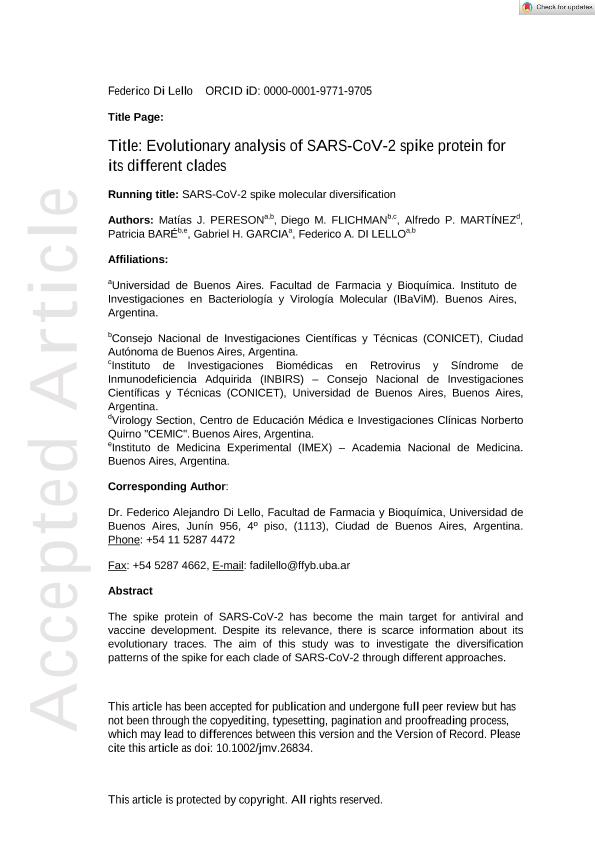Mostrar el registro sencillo del ítem
dc.contributor.author
Pereson Moschen, Matias Javier

dc.contributor.author
Flichman, Diego Martin

dc.contributor.author
Martínez, Alfredo P.
dc.contributor.author
Baré, Patricia

dc.contributor.author
García, Gabriel Hugo

dc.contributor.author
Di Lello, Federico Alejandro

dc.date.available
2021-07-07T02:28:58Z
dc.date.issued
2021-01-29
dc.identifier.citation
Pereson Moschen, Matias Javier; Flichman, Diego Martin; Martínez, Alfredo P.; Baré, Patricia; García, Gabriel Hugo; et al.; Evolutionary analysis of SARS-CoV-2 spike protein for its different clades; Wiley-liss, div John Wiley & Sons Inc.; Journal of Medical Virology; 93; 5; 29-1-2021; 1-15
dc.identifier.issn
0146-6615
dc.identifier.uri
http://hdl.handle.net/11336/135610
dc.description.abstract
The spike protein of severe acute respiratory syndrome coronavirus 2 (SARS-CoV-2) has become the main target for antiviral and vaccine development. Despite its relevance, e information is scarse about its evolutionary traces. The aim of this study was to investigate the diversification patterns of the spike for each clade of SARS-CoV-2 through different approaches. Two thousand and one hundred sequences representing the seven clades of the SARS-CoV-2 were included. Patterns of genetic diversifications and nucleotide evolutionary rate were estimated for the spike genomic region. The haplotype networks showed a star shape, where multiple haplotypes with few nucleotide differences diverge from a common ancestor. Four hundred seventy-nine different haplotypes were defined in the seven analyzed clades. The main haplotype, named Hap-1, was the most frequent for clades G (54%), GH (54%), and GR (56%) and a different haplotype (named Hap-252) was the most important for clades L (63.3%), O (39.7%), S (51.7%), and V (70%). The evolutionary rate for the spike protein was estimated as 1.08 × 10−3 nucleotide substitutions/site/year. Moreover, the nucleotide evolutionary rate after nine months of the pandemic was similar for each clade. In conclusion, the present evolutionary analysis is relevant as the spike protein of SARS-CoV-2 is the target for most therapeutic candidates; besides, changes in this protein could have consequences on viral transmission, response to antivirals and efficacy of vaccines. Moreover, the evolutionary characterization of clades improves knowledge of SARS-CoV-2 and deserves to be assessed in more detail as re-infection by different phylogenetic clades has been reported.
dc.format
application/pdf
dc.language.iso
eng
dc.publisher
Wiley-liss, div John Wiley & Sons Inc.

dc.rights
info:eu-repo/semantics/openAccess
dc.rights.uri
https://creativecommons.org/licenses/by-nc-sa/2.5/ar/
dc.subject
CLADES
dc.subject
EVOLUTION
dc.subject
SARS-COV-2
dc.subject
SPIKE PROTEIN
dc.subject
COVID-19
dc.subject.classification
Enfermedades Infecciosas

dc.subject.classification
Ciencias de la Salud

dc.subject.classification
CIENCIAS MÉDICAS Y DE LA SALUD

dc.title
Evolutionary analysis of SARS-CoV-2 spike protein for its different clades
dc.type
info:eu-repo/semantics/article
dc.type
info:ar-repo/semantics/artículo
dc.type
info:eu-repo/semantics/publishedVersion
dc.date.updated
2021-07-05T18:16:21Z
dc.journal.volume
93
dc.journal.number
5
dc.journal.pagination
1-15
dc.journal.pais
Estados Unidos

dc.description.fil
Fil: Pereson Moschen, Matias Javier. Consejo Nacional de Investigaciones Científicas y Técnicas; Argentina. Universidad de Buenos Aires. Facultad de Farmacia y Bioquimica. Instituto de Investigaciones En Bacteriologia y Virologia Molecular; Argentina
dc.description.fil
Fil: Flichman, Diego Martin. Consejo Nacional de Investigaciones Científicas y Técnicas; Argentina. Consejo Nacional de Investigaciones Científicas y Técnicas. Oficina de Coordinación Administrativa Houssay. Instituto de Investigaciones Biomédicas en Retrovirus y Sida. Universidad de Buenos Aires. Facultad de Medicina. Instituto de Investigaciones Biomédicas en Retrovirus y Sida; Argentina
dc.description.fil
Fil: Martínez, Alfredo P.. Centro de Educación Médica e Investigaciones Clínicas "Norberto Quirno"; Argentina
dc.description.fil
Fil: Baré, Patricia. Consejo Nacional de Investigaciones Científicas y Técnicas. Instituto de Medicina Experimental. Academia Nacional de Medicina de Buenos Aires. Instituto de Medicina Experimental; Argentina
dc.description.fil
Fil: García, Gabriel Hugo. Universidad de Buenos Aires. Facultad de Farmacia y Bioquimica. Instituto de Investigaciones En Bacteriologia y Virologia Molecular; Argentina
dc.description.fil
Fil: Di Lello, Federico Alejandro. Universidad de Buenos Aires. Facultad de Farmacia y Bioquimica. Instituto de Investigaciones En Bacteriologia y Virologia Molecular; Argentina. Consejo Nacional de Investigaciones Científicas y Técnicas; Argentina
dc.journal.title
Journal of Medical Virology

dc.relation.alternativeid
info:eu-repo/semantics/altIdentifier/url/https://onlinelibrary.wiley.com/doi/10.1002/jmv.26834
dc.relation.alternativeid
info:eu-repo/semantics/altIdentifier/doi/https://doi.org/10.1002/jmv.26834
Archivos asociados
